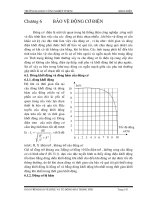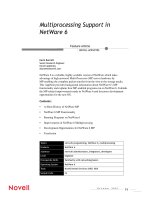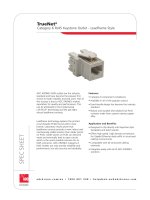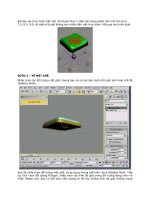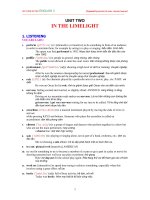Tài liệu Multiprocessing Support in Netware 6 pdf
Bạn đang xem bản rút gọn của tài liệu. Xem và tải ngay bản đầy đủ của tài liệu tại đây (387.15 KB, 13 trang )
)HDWXUH $UWLFOH
129(// $33127(6
.94-07
0XOWLSURFHVVLQJ6XSSRUWLQ
1HW:DUH
.HYLQ %XUQHWW
6HQLRU 5HVHDUFK (QJLQHHU
1RYHOO $SS1RWHV
NEXUQHWW#QRYHOOFRP
NetWare 6 is a reliable, highly-scalable version of NetWare which takes
advantage of high-powered Multi-Processor (MP) server hardware by
MP-enabling the complete packet transfer from the wire to the storage media.
This AppNote provides background information about NetWare 6’s MP
functionality and explains how MP-enabled programs run on NetWare 6. It details
the MP-related improvements made in NetWare 6 and discusses development
opportunities for the new OS.
&RQWHQWV
• A Short History of NetWare MP
• NetWare 6 MP Functionality
• Running Programs on NetWare 6
• Improvements in NetWare 6 Multiprocessing
• Development Opportunities for NetWare 6 MP
• Conclusion
7RSLFV QHWZRUN SURJUDPPLQJ 1HW:DUH PXOWLSURFHVVLQJ
3URGXFWV 1HW:DUH
$XGLHQFH QHWZRUN DGPLQLVWUDWRUV LQWHJUDWRUV GHYHORSHUV
/HYHO EHJLQQHU
3UHUHTXLVLWH 6NLOOV IDPLOLDULW\ ZLWK QHWZRUNLQJ EDVLFV
2SHUDWLQJ 6\VWHP 1HW:DUH
7RROV 1RYHOO .HUQHO 6HUYLFHV 1.6 1'.
6DPSOH &RGH QR
ZZZQRYHOOFRPDSSQRWHV
$ 6KRUW +LVWRU\ RI 1HW:DUH 03
NetWare 6 is Novell’s second-generation MP network operating system. Actually
it could be looked at as being a third generation, as you will see from this short
history. Novell introduced MP functionality with NetWare 4.x. This first attempt
was somewhat limited in functionality in that the core operating system (OS) was
not MP-enabled. All of the core OS functionality had to be funneled to processor
0, which is the default processor that threads are run on when the application is
not MP-compliant. This version of NetWare allowed applications that were
written to the MP standard to run on processors other than processor 0. But any
time the application needed to use core OS functionality—disk access, transmit on
the wire, and so on—the request had to be reverted back to processor 0. Hence, it
was not a complete solution.
With the advent of NetWare 5, the MP functionality was completely rewritten and
integrated into the NetWare OS Kernel. This made the vast majority of OS
functionality MP-compliant. However, there were still some essential services
that had to run on processor 0. Functionality such as LAN drivers and disk drivers
still needed to be MP-enabled.
In NetWare 6, all components are MP-compliant. The whole chain of events, from
the network wire to the hard disk storage devices, is MP-enabled. Thus with
NetWare 6, Novell now provides a complete MP server solution.
1HW:DUH 03 )XQFWLRQDOLW\
NetWare 6 has been designed from the ground up to run on Symmetric
Multiprocessing (SMP) hardware. Typically, a computer hardware manufacturer
will refer to a SMP machine as a “high-end server.” Today, SMP machines are
shipped with one to 32 processors. In most cases, the machines are processor
upgradable, meaning you can add processors as your needs demand it. A benefit
of upgrading to an SMP machine is that you can have a server with six processors
doing the work that up to six separate servers used to do.
As shipped, NetWare 6 includes the following MP-enabled components:
3URWRFRO 6WDFNV
1HW:DUH &RUH 3URWRFROV 1&3
6HUYLFH /RFDWLRQ 3URWRFROV 6/3
,3 6WDFN
+773
(WKHUQHW &RQQHFWLYLW\
7RNHQ 5LQJ &RQQHFWLYLW\
:HEEDVHG 'LVWULEXWHG $XWKRULQJ DQG 9HUVLRQLQJ :HE'$9
/LJKWZHLJKW 'LUHFWRU\ $FFHVV 3URWRFRO /'$3
2FWREHU
Before we discuss MP and the way it is implemented in NetWare 6, a discussion
of threads is in order. This is because to truly understand MP, you need to
understand threads.
7KUHDGV LQ 1HW:DUH
Ever since NetWare was first released, it has used the concept of threads to allow
the NetWare OS to work efficiently. A thread is simply a NetWare OS process,
but in technical terms a process is slightly different from a thread. A process
typically saves most of the processor’s state when it is swapped out, while a
thread typically saves less of the processor’s state. What’s more, processes are
usually preemptive (they take control of all resources, but can be interrupted)
compared to threads, which are nonpreemptive (they run to completion).
The NetWare OS schedules different threads to run in its Run queue. The threads
are executed in a first-in first-out (FIFO) order. In addition, the NetWare OS
allows NetWare Loadable Module (NLM) applications to establish multiple
threads, each representing a distinct path of execution. An NLM has to contain
one thread at the minimum, but typically will contain two or more threads.
Only one thread can run at a time. While the thread is running, it has control of the
system’s microprocessor (CPU). NetWare is a nonpreemptive OS, meaning it
allows threads to run to completion once they start to execute. When a thread
gains control of the CPU, the thread remains in control until it has run to the end
of its execution, or until it relinquishes control and reschedules itself on the run
queue. In an MP world, this refers to one processor in the server.
Storage Services
1RYHOO 6WRUDJH 6HUYLFHV 166
'LVWULEXWHG )LOH 6HUYLFH '66
3URWRFRO 6HUYLFHV 5HTXHVW 'LVSDWFKHU
7UDQVSRUW 6HUYLFH 5HTXHVW 'LVSDWFKHU
)LEHU &KDQQHO 'LVN 6XSSRUW
Security Services
1RYHOO ,QWHUQDWLRQDO &U\SWRJUDSKLF ,QIUDVWUXFWXUH 1,&,
$XWKHQWLFDWLRQ
$XWKHQWLFDWLRQ &RQVROH2QH VQDSLQV
Miscellaneous Components and Services
H'LUHFWRU\ 1'6
1RYHOO -DYD 9LUWXDO 0DFKLQH -90
:HE(QJLQHV
$GGLWLRQDO :HE)HDWXUHV
ZZZQRYHOOFRPDSSQRWHV
0XOWLSURFHVVLQJ
Looking at classic NetWare 5.x on a one-processor box, it appears that NetWare is
executing two or more applications or functions at the same time. This is referred
to as multitasking. NetWare is a multitasking OS since it gives the illusion that a
single CPU is executing two or more programs at once. However, in reality, it is
executing the threads in these programs in a consecutive manner.
Running on one processor, a multithreaded and multitasked OS such as NetWare
can’t execute more than one thread at one time. Even if you have a multi-CPU
computer, you will not be able to exploit the additional CPUs unless you have
applications that are specifically written to be multi-processor compliant or
MP-enabled. MP-enabled applications are programmed in such a way that their
threads can safely execute simultaneously on multiple processors. With NetWare
6 and properly programmed MP-enabled applications, multitasking becomes a
reality. Your applications can execute multiple threads on multiple processors at
the same time!
6HUYHU +DUGZDUH 6SHFLILFDWLRQV
To get the most out of what NetWare 6 has to offer, appropriate hardware is a
must. NetWare 6 supports hardware that is designed around Intel’s Multi-
Processor Specification (MPS) v1.4. This specification is used by PC
manufacturers to design and build Intel-based systems that use two or more
processors. The current version (1.4) includes support for multiple PCI buses,
future expandability, and up to 32 processors (see Figure 1).
Figure 1: 036 KDUGZDUH EXV
.94-07
As seen in Figure 1, MPS v1.4 defines a specification where all of the processors
in the system work and function together similarly. All the processors in the
system share a common I/O subsystem and also use the same memory pool.
MPS-compatible operating systems are able to run without special customization
on multiprocessor systems that comply with this specification. End-users who
purchase a compliant multiprocessor system will be able to run their choice of
operating systems.
Since NetWare 6 complies with Intel’s specification, it will automatically take
advantage of all the processors in your MPS hardware—provided the MPS
hardware supports the Intel specification. That really shouldn’t be a problem since
the major computer manufacturers, such as Dell and Compaq, support the
specification.
If you are interested in reading the complete Intel MPS v1.4 specification, it is
available at Intel’s site:
/>While we are talking about MP hardware, we should clear up one common
misunderstanding. Many people assume that if they buy a two- processor
MPS-enabled machine, they will get the equivalent processing power of two
separate and distinct servers. While this is the goal of MP hardware and software
engineers, this is not the case in our imperfect world. The general rule is this: as
the number of processors increases, the processing power increases, but to a
somewhat lesser degree. So with a two- processor MPS system you get roughly
1.8 times as much processing power as a server with one processor. A
four-processor system offers about 3.5 times as much processing power, and a
six-processor system offers about 5.2 times the processing power.
5XQQLQJ 3URJUDPV RQ 1HW:DUH
After you have installed NetWare 6 on your MPS hardware and started it up, the
NetWare 6 Kernel determines how many processors are in the system. Next, the
Kernel’s Scheduler determines which processor to run the available threads on.
This decision is based on information about the threads themselves and on the
availability of processors.
Three types of programs can run on NetWare 6:
• MP Safe
• MP Compliant
• NetWare OS
